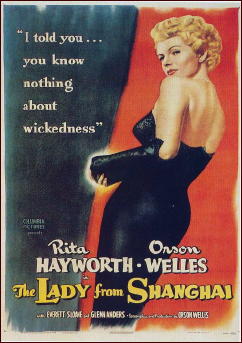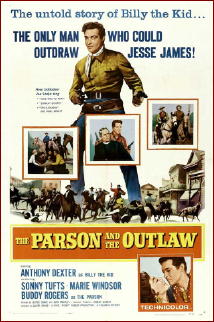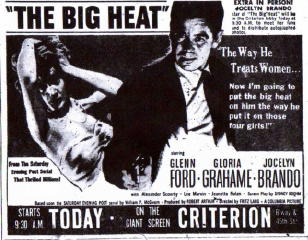January 2014
Monthly Archive
Thu 30 Jan 2014
REVIEWED BY DAN STUMPF:
SHERWOOD KING – If I Die Before I Wake. Simon & Schuster, hardcover, 1938. Mystery Novel of the Month #16, digest-sized paperback, [1940]. Ace Double D9, paperback, 1953 (published back-to-back with Decoy, by Michael Morgan). Curtis 7154, paperback, 1965.
THE LADY FROM SHANGHAI. Columbia Pictures, 1947. Rita Hayworth, Orson Welles, Everett Sloane, Glenn Anders. Based on the novel If I Die Before I Wake, by Sherwood KIng. Director: Orson Welles.
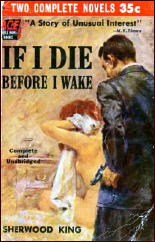
Sherwood King’s If I Die Before I Wake offers an intriguing premise: Laurence Planter is something of a footloose jack-of-some-trades marking time, as the story starts, as a chauffeur to criminal attorney Mark Bannister and his trophy wife Elsa. He also spends a lot of time running Bannister’s partner Grisby back and forth from the Bannister house to the office.
It’s on one of those runs that Grisby offers Laurence five thousand dollars to commit murder — the murder of Grisby himself.
It’s a neat book, with an even neater twist to it: Grisby wants to fake his death by having witnesses see Laurence walk to the end of a dark pier with him, hear a shot and see Laurence come back alone. But no corpse will be found — Laurence can’t (he thinks) be charged with murder, but Grisby will (he thinks) be legally dead.
And the scheme seems to work quite nicely until Laurence goes through with it and signs a confession,only to have Grisby’s body turn up after all — very very murdered.
As I say, it’s a clever hook for a story, and Cornell Woolrich could have made a nightmarish classic of it, but Sherwood King just lets it lie there with the sharp end sticking up. There’s not much action in the story and very little movement at all, as if King were too lazy to describe new locations for us. Instead,he opens the tale with awkward dialogue, then gets bogged down in a lengthy trial scene capped off with a resolution that’s all talk. And so another good idea misfires.
But wait….
The story goes that in 1946 Orson Welles was trying to raise money from Harry Cohn, the head of Columbia Pictures, and during a desperate conversation in a drugstore phone booth his eye fell upon a paperback book he’d never read and he suddenly convinced Cohn it would make a great movie, which he could direct and star in with his then-wife, Columbia’s leading lady Rita Hayworth.
Well, it’s a nice story and it may even be true, despite reports that Columbia already owned If I Die Before I Wake and was planning to have contract director William Castle make it as a B movie. (It would have made a good entry in the Whistler series.)
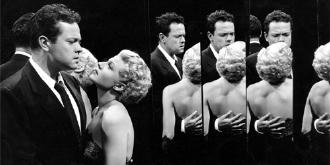
Whatever the case, Welles took the basic plot and most of the details and turned The Lady from Shanghai (its new title) into his most enjoyable film, a tricky, fast-moving, witty, careening ride form Central Park, through Acapulco (some of this was filmed on board Errol Flynn’s yacht) to San Francisco’s Chinatown, culminating in a visual tour-de-force: the shoot-out in a hall of mirrors where, as one critic noted, the characters have to come face-to-face with themselves before meeting their end.
Welles plays the hero like a young Falstaff, lustful, charming, and all too aware of his own fecklessness. He’s abetted by Rita Hayworth as the duplicitous wife — though he doesn’t give his then-wife much to do. I’ve seen her more effective in the hands of lesser directors — but the films is helped along splendidly by Everett Sloane and Glenn Anders as lawyers Bannister and Grisby.
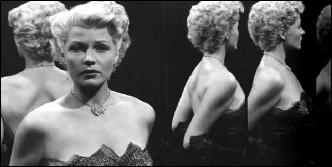
Except for a part in Tarzan’s Peril, I never heard of Glenn Anders before and after this film, and he reportedly had an awful time making it, but his performance as Grisby is one of high points of the American Cinema: sweaty, smiling, whiny and worming, he seems so devoid of humanity — of perhaps so excessively human — that you can’t figure out why no one ever killed him before the picture started.
His performance complements Welles’ visual excesses perfectly, and I’ve always thought it an overlooked gem in a treasure-trove of a film.
Wed 29 Jan 2014
DAVID HILTBRAND – Killer Solo. Avon, paperback original. First printing, January 2004.
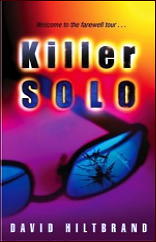
I was going to start this review by stating that this is the best rock music detective novel I have ever read. It then occurred to me that this may be the only rock music detective novel I have ever read. I know there are others. Unless there are some that aren’t coming to mind right now, though, I just haven’t read them.
Forgive me if you’re not a rock music fan. I’m going to quote the entire first page. You can skip this and go on the rest of review, if you want to. In fact, you can even go on to the next review, if you want to. I can’t stop you.
The house lights dimmed and the crowd erupted, a scalding howl of bloodlust and anticipation. The PA system began pumping out strange Sufi snake-charming music that became more insistent and penetrating as it gradually grew louder and faster. The audience, already stoked, got swept up by this swirling, modal sound – hypnotic music that seemed to climb and coil around your brain stem.
Roadies were leading band members out onto the dark stage, focusing hooded flashlights down at their feet. The people at the front of the arena were the first to notice the eerie processional and their cries of delight swept like a paper fire past where I stood behind the mixing board to the back of the floor and up into the tiers of balconies.
All the time, the crowd and the music continued to feed off one another. At the precise moment that the tension inside the arena crested, flash bombs exploded, clusters of spotlights began raking the hall and the wild dervish music segued ingeniously into the thunderous opening chords of “Blood Money.†And Shirley Slaughterhouse was there. In fact, he was everywhere.
Wow. David Hiltbrand nails it, as far as I’m concerned. And it’s no wonder. The brief bio on the inside back cover points out that among other things, he’s been a rock journalist for a number of well known magazines and newspapers. (He’s currently a consulting editor for TV Guide.)
Working out of Winsted CT as an insurance investigator is Jim McNamara, á la old time radio’s Johnny Dollar, who in his many years on the air may have checked out a mysterious death on a rock band’s tour, but if he did, I haven’t listened to it yet.
Dead is Shirley’s good buddy, Jake Karn, and one of the crew. He fell off a catwalk after a show late at night, and Jim is asked to see if foul play could have been involved.
Back to Shirley, who is male, and who is described on page 7 as “the one who looks like Johnny Depp with dysentery.†It takes some time, but Jim, at one time also heavily involved in the world of rock music, eventually gets on his good side, following along with the tour from city to city, a brutally honest behind-the-scenes inside look. Quoting again, this time from page 136:
… I marveled that Shirley could be miserable when most people under the age of thirty would give anything in the world to trade places with him. … If someone like Shirley can’t be happy, what chance do us sad-sack civilians have?
Musicians, groupies, roadies, managers, PR people and more, they’re all represented, and they’re all among the suspects. Jim works alone, but since he needs someone to bounce ideas off, he has his AA sponsor to talk to by telephone, not to mention the girl friend he picks up along the way.
So how’s the mystery, someone asks. More than tolerable, is my reply, with enough suspects and opportunity and motive to accommodate two books, and by the way, if there’s a second one coming in the series, it would be OK by me.
The ending of this one is rather over the top, I hasten to caution you, including the killer (yes, it was murder) giving a long ten-page explanation of everything that went on prior to then, when the realistic course of action is to simply do away with one nosy insurance investigator.
My first sentence still holds, though.
The Jim McNamara series —
1. Killer Solo (2003)
2. Deader Than Disco (2005)
3. Dying to Be Famous (2006)
Mon 27 Jan 2014
Reviewed by DAVID VINEYARD:
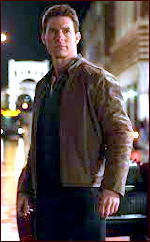
JACK REACHER. Paramount Pictures, 2013. Tom Cruise, Rosamund Pike, Richard Jenkins, Werner Herzog, Robert Duvall, David Oyelowo. Based on the novel One Shot by Lee Child. Directed by Christopher McQuarrie (also screenplay).
“There’s this guy, he doesn’t care about law, he doesn’t care about proof. He cares about what’s right. He knows what I did. He knows where I am. And this guy, he made me a promise, if I ever got in trouble he’d be there.â€
Who was that masked man?
Actually he’s Jack Reacher, hero of a series of books by British television writer Lee Child, a cross between Travis McGee, Mike Hammer, and. yes, the Lone Ranger. Here he’s played by super star Tom Cruise. Reacher really isn’t a hero, he’s a sociopath gone off the grid out of paranoia and what fits every definition of schizo effective disorder ever penned, whose tarnished armor should be replaced by a strait jacket.
Unlike both McGee and Hammer Reacher has no self recognition, no dark nights of the soul when he questions himself or his motives. He’s a sociopath incapable of examining his own motives, actions, or morality. Showtime’s Dexter is better balanced and he’s a serial killer.
Confession time before I go any farther. I find the Reacher books appallingly written, inauthentic, badly researched, and universally stupid. I don’t like them much either. Child is the type writer who thinks he sounds like an American if he uses “guy†twenty to thirty times on the same page.
He makes huge gaping mistakes like putting a military base in Dallas (save for the Naval Air Station, Dallas never had a base — ever — not at all — not even in WW II), and going on for an entire book about how ineffective a .38 caliber gun is and then praising the 9mm automatic. The .38 and the 9mm are damn near the same thing (9 mm is .35 inches — you would think a Brit would know the metric system), he also seems ignorant of the fact that the .38 revolver is one of the most efficient hand guns ever made.
If he thinks getting shot by a .38 is nothing he should recall what a .22 did to President Reagan. In another book the Secret Service hires him to stalk the Vice President like a real assassin — this despite the fact he is homeless loner living off the grid. No trouble buying that plot. These things add up over time.
I’m not a gun nut, and better writers than Child have made such mistakes (Ian Fleming for one), but they don’t rant for three hundred pages about it, and they didn’t have the Internet at their fingertips.
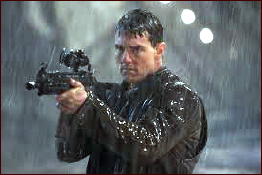
This is symptomatic of the problems I have with Child and the movie made from his book. There is nothing original, nothing new, nothing period. This isn’t up to the level of the generic paperback series of my youth or the later Men’s Action series.
I promise you Mack Bolan knew what gun he was using whether he knew syntax or not. This isn’t as good as run of the mill series television from that era either. The plot pretty much is run of the mill television.
In addition Reacher is a huge pain in the ass, always right, always the smartest, toughest, most ‘perfectest’ hero in the game. He’s so perfect he gives me dyspepsia. Casting Tom Cruise in the role didn’t help things much, humility is not one of his stronger acting skills.
Confession Part deux, I’m no Cruise fan. I particularly don’t like him when he tries to play a flawless hero, but he can be great when he either laughs at himself (Knight and Day) or allows his hero to be human.
He’s much better in films like the Mission Impossible series (his character in these films differs from Reacher in that he is usually fighting great odds with his life or that of his loved ones at stake), Minority Report, Risky Business, Rain Man, or Born on the Fourth of July playing fallible humans often battling huge odds, heroes struggling to reclaim their lives, or men struggling with difficult moral problems with a flawed character.
At least in Top Gun his character had something to be arrogant about in a profession that calls for more than a little over confidence, and it was only a little exaggerated about what personalities make great fighter pilots.
As Jack Reacher he doesn’t make the ‘guy’ heroic or iconic, he plays him as a horses rear, a rude creepy loner who has watched too many James Dean movies without noticing the humanity under Dean’s cool. You’ll be excused if you root for the villain.
At the point where the great Robert Duvall comes in as a colorful aging gun dealer playing Tonto to Reacher’s Lone Ranger in a terribly written role, the patter between the two actors will make you remember the Bowery Boys fondly. God awful is the only description I can give of it. I hope at least Duvall got a bundle for it. Something good should come from this movie.
Joe Kraemer’s score did win an award and the trailer was great, but the movie, not so much. It had a great opening weekend in theaters, but in the end didn’t bring in that much more than it cost ($20 million is not considered a profit in Hollywood these days, not the way they calculate it), so audiences do have taste and word of mouth lives.
The plot is incredibly cliched, obvious, and plain silly. The screenplay and book were apparently written by Marconi, because every twist and turn is telegraphed with the subtly of a hammer on an anvil.
Former army sniper James Barr (Joseph Siroka) stands accused of a killing spree and calls on Reacher, a former MP who once proved Barr murdered four people in Afghanistan but couldn’t nail him because the army needed a hero. Reacher would be perfectly happy to see Barr dead, but he agrees to work with Barr’s lawyer Helen Rodin (Rosamund Pike) who just happens to be the prosecutor’s daughter and has daddy issues.
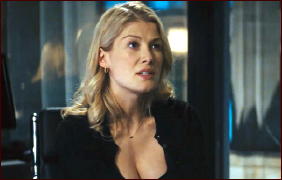
She and Reacher semi flirt, but it is so lead footed there is never any question of them getting together. Pike is attractive, and shows a bit of cleavage, but it’s not enough to keep you sitting through this. She does what she can with nothing much to work with. A better movie would have dropped Reacher and focused on her more interesting character, but then you have to explain the title.
David Oyelowo isn’t bad as the assassin Reacher battles, but he has nothing to work with. Maybe in a later movie we’ll see what he can do. Werner Herzog does creepy great, but it’s too little too late.
Reacher is of course devastating with women, and a devastating wit. as this little exchange will show.
Girl (Alea Fast): Mind if I share your table, I’m Sandy.
Reacher: “So was I last week at the beach.
What Shavian wit. James Bond will have to retire his Bond mots. How can you top wit like that? I don’t know how Cruise delivered the line without laughing — or crying. That is pitifully bad, but then most of this film is.
John Gardner, the American one, wrote in an essay about what he called Dis-Pollyanna, an unearned cynical pose assumed by people with no life experience to base that cynicism on. That’s Child. It’s second hand life picked up from books, television, and movies not experience. It’s imitative of people who earned that voice like his models John D. MacDonald and Mickey Spillane, but theirs was real coming from their lives. Child’s is coming from episodes of Magnum P.I. (but not as well written or directed, much less acted). Peter Cheyney’s Lemmie Caution was more authentic, and Lemmie was at least funny. Reacher is just depressing.
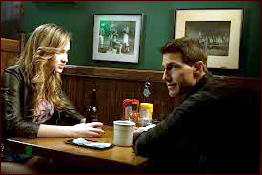
I won’t give away the plot save to say it is incredibly hackneyed, a plot device so old Street and Smith would have hesitated to put Nick Carter through it in the Nickel Library. Worse still, it is ineptly done. The second hand action scenes have been done better on television and the car chases were better choreographed on Rockford Files and Mannix.
There is one line that defines the film perfectly: “It’s grassy knoll ridiculous.â€
As played by Tom Cruise in this disaster of a film Jack Reacher lacks the substance of corrugated cardboard.
Reacher even puts down his gun when he has the bad guy dead to rights to fight him hand to hand when Helen Roden is still hostage to a man who has orchestrated countless murders.
Didn’t these people learn anything from Indiana Jones in Raiders of the Lost Ark? Who is he, Roy Rogers? No, I apologize to Roy, he never pulled a boner like that while there was a gun at Dale’s head.
This cost me $1.20 to rent from a Redbox kiosk. I was cheated. Don’t you be, this was even worse than the last Die Hard movie, and that was one of the worst blockbusters of the year.
Flat, cliched, obvious, poorly written, with no real action, drama, or characters to root for, this is a painfully bad movie with a plot they would have rejected for an episode of The Dukes of Hazard.
And it is exactly the movie Jack Reacher and Lee Child deserved, but not their fans who deserve much more than this cynically made half-hearted effort at starting another franchise for Cruise. Nothing much happens in the film and what does happen is pretty inept.
I can’t even recommend this as a good bad movie, it’s not enough fun to even laugh at.
Sun 26 Jan 2014
Posted by Steve under
Reviews[6] Comments
IT IS PURELY MY OPINION
Reviews by L. J. Roberts
FELIX FRANCIS – Dick Francis’s Refusal. Putnam, hardcover, September 2013. Berkley, softcover, July 2014.
First Sentence: “No,†I said.

Sid Halley is married, a father, and six years retired from doing investigative work. Sir Richard Stewart approaches him asking that Sid look into race results that seem wrong. Although Sid is curious, he refuses but agrees to look over the information. However, the next day Sir Richard is found dead in his car of an apparent suicide and Sid receives a phone call, followed by escalating threats, demanding he sign a report of no wrong-doing … or else.
Having read every book written by Dick Francis, I knew I was starting with a bias. However, even distancing myself from that and trying to view this as a book from a completely different author, it did not help.
There were several major problems with this book. First, the characters. The two best characters were Charles and Chico. Sid’s wife was very poorly written. Even as a mother, worried about her child, she was overly strident and annoying. She did not convey as the type of woman Sid would have married.
Sid may have been retired for six years, but he came across as soft and insecure. Francis’s protagonists were known for their determination and doggedness. They didn’t give up, they never whined and they certainly would never have considered asking a policeman to break the law, or committing murder or blackmail.
The dialogue lacked a natural flow. I don’t know whether this was due to this being an “American†version — why do they do that? — rather than U.K, but it was choppy and somewhat painful.
On the plus side, there was fascinating information on the technological advancements in limb replacement, both with mechanical, and now, actual limb transplants. The plot did have some very good twists. Even when you think Francis has made an error, it’s lovely to discover he hasn’t.
Refusal isn’t a dreadful book, but it’s just not a very good one either. The biggest mistake was probably to resurrect Sid Halley, a character so well known and well loved by Dick Francis fans. I suspect that had one not read previous books, one would enjoy this far better than did I.
Rating: Poor.
Sun 26 Jan 2014
THE PARSON AND THE OUTLAW. Columbia Pictures, 1957. Anthony Dexter, Sonny Tufts, Marie Windsor, Buddy Rogers, Bob Steel(e). Director: Oliver Drake.
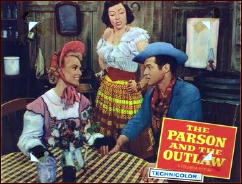
Yet another fictional distortion of the legend of Billy the Kid, but one in which I have to admit a really neat twist takes place. It seems that what really happened was this: Pat Garrett and Billy got together on a plot that would leave Billy “dead” and buried, free to begin a new life, one without the need to constantly prove himself to every new gunfighter in town.
This all takes place in the first ten minutes, so I’m not telling you all that I could, but unfortunately, it is the most interesting ten minutes of the movie — as maybe you could tell from just a single glance at the cast.
Marie Windsor excepted, of course.
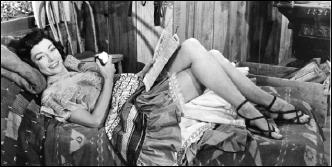
As Billy the Kid, Anthony Dexter has no acting ability, no looks, and is minus 30 on the standard Sonny Tufts charisma scale. (Which means that Sonny Tufts has 30 times the charm and charisma of Anthony Dexter, as displayed in this movie.)
On the other hand, no movie with Marie Windsor in it is ever a complete waste of time, but a few of them come close, and even fewer of them come closer than this.
And what other movie can you think of would have the parson, a man of the cloth, begging Billy to put his guns back on, for the sake of the town. (It works out even worse than you might think.)
— Reprinted from Mystery*File 37, no date given, slightly revised.
Fri 24 Jan 2014
Posted by Steve under
Reviews[4] Comments
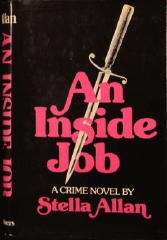
STELLA ALLAN – An Inside Job. Avon, US, paperback, 1980. First published in the UK by Collins, hardcover, 1978; Charles Scribner’s Sons, US, hardcover, 1978.
Most of the mainstream critics who commented on the recent movie Body Heat compared it, not illogically, to the works of James M, Cain. Those of us in the know (as we’re prone to say) will also say that here was the closest adaptation of an old Gold Medal paperback novel that’s ever been made.
Consider the theme: an unwary male victim is caught up in the temptations of a beautiful woman’s lush afterglow, sinking him deeper and deeper into a never-ending web of crime and deceit. Raiders of the Lost Ark notwithstanding, Body Heat certainly got my vote for the movie of the year. It simply sizzled.
But back to the tale at hand. This nifty little novel of murder and retribution neatly reverses the theme of all those sultry paperback novels of the 50’s. This time around a feminist it is, rising to the top of the business world, who finds herself putty in the hands of her best friend’s husband.
Times have changed, and the roles have been reversed. The ensuing death of Sheila Pettit’s employer and long-time mentor causes her no feeling of sorrow or regret. And this could be the greatest problem you will find with this book. None of the people involved could be described as even half-way appealing. The futures they cut out for themselves no one could possibly conclude are other than what they most richly deserve.
Rating: B minus
— Reprinted from
The MYSTERY FANcier, Vol. 6, No. 3, May-June 1982 (slightly revised).
Thu 23 Jan 2014
THE BACKWARD REVIEWER
William F. Deeck
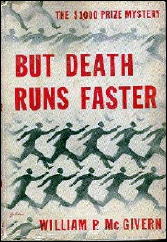
WILLIAM P. McGIVERN – But Death Runs Faster. Dodd Mead, hardcover, 1948; Pocket #693, 1950, as The Whispering Corpse. Berkley, paperback, 1988, under original title.
Tone-Bailey Publishing Company hires Steve Blake, mystery writer and author of Nor Live So Long among other novels, to edit a new pulp magazine, Modern Detective. (Little did they know that the handwriting was on the wall and that it approximated mene, mene, tekel, upharsin.)
Blake lacks editing experience, so he hires as assistant editor Byron Crofield, a young man who has editing experience and who has written some not-very-good books. Crofield turns out to be an absolute bounder, who probably also has no talent. Crofield dabbles in blackmail for the pleasure of distressing people, and he takes great delight in antagonizing his co-workers, including his employer.
When Crofield is murdered after a party to which he has invited all those who had reason to thoroughly dislike him, the suspects are not scarce.
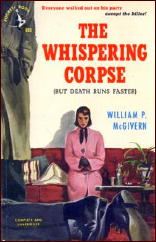
Blake’s secretary, a young lady who was raped when very young and is both shy and fearful of men, receives a calI from Crofield short!y before his death telling her that Blake is at Crofield’s apartment, is drunk, and is threatening him with bodily harm. She then hears Crofield say, “Christ, Steve, don’t,” followed by two shots. Of course, this very timorous person immediate!y rushes to the apartment and finds Crofield dead.
If you can tolerate that extreme unlikelihood, all else should be acceptable, including Blake’s blurting out over the phone without being aware to whom he was talking information that causes another killing.
Blake, in my opinion, shares some of the less pleasant aspects of the murdered bounder, although he is not aware of it and I doubt that the author intended it. Thus, he is not a particularly sympathetic character. On the other hand, the information about pulp magazines, along with some of the discussions by pulp writers, whom McGivern does not treat very kindly, makes this an interesting novel from that aspect.
— From The MYSTERY FANcier, Vol. 10, No. 1, Winter 1988.
Wed 22 Jan 2014
Reviewed by
CAPTAIN FRANK CUNNINGHAM:
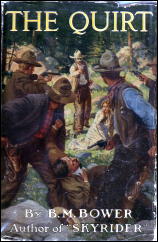
B. M. BOWER – The Quirt. Little Brown, hardcover, 1920. Thrilling Novels #15, digest-sized paperback, [1948]. Also available in several Print on Demand editions; a free ebook edition can be downloaded here.
This story of the cow country concerns the efforts of the Sawtooth Cattle Company, who number their cattle by the tens of thousands, to eliminate the smaller outfits around.
Al Woodruff, the evil eye of the Sawtooth, is efficient in his particular line of work, which is the reason why Brit Hunter of the Quirt ranch calls life in the Sawtooth country “extra hazardous.”
Hunter’s daughter Loraine, a city-bred girl, whose ideas of the Wild West have been obtained in the movies, arrives for a visit just in time to witness an incident of real tragedy, and in her ignorance of conditions she talks enough to arouse the ire of Al Woodruff and thus brings upon her father the neecessity of making a fight for his ranch and his life.
Action and adventure there are a-plenty.
— Reprinted from
Black Mask magazine, August 1920.
Tue 21 Jan 2014
THE BIG HEAT. Columbia Pictures, 1953. Glenn Ford, Gloria Grahame, Jocelyn Brando, Alexander Scourby, Lee Marvin, Jeanette Nolan, Peter Whitney. Based on the novel by William P. McGivern. Director: Fritz Lang.
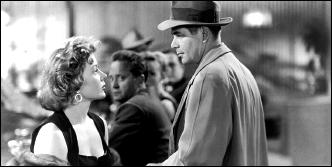
This one preceded Human Desire, which came out in 1954, with the same two stars (Ford and Grahame), the same director, and if you were to ask me which one I like better, I’m not sure I can tell you.
This is the one that’s freshest in my mind, however, so right now I’d probably give it the edge. While The Big Heat is not a movie without flaws, it has a lot of things going for it: atmosphere (crime and corruption in a big city), a plot that takes some interesting twists and turns, and some good performances, especially by Gloria Grahame as a gangster’s girl who dies in the end, with Glenn Ford playing the homicide detective who’s trying to run the city’s crime boss to earth.
Lee Marvin, in what must have been an early film for him, also makes a strong impression as the sadistic hoodlum who takes great pleasure in burning and tormenting women. Surprisingly, its Glenn Ford himself who seems rather innocuous and bland, as if to say there is nothing interesting to say about knights in white armor.
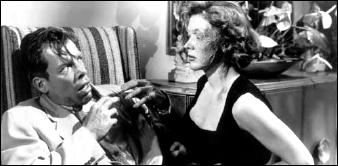
Villains, or at least those with pasts they are trying vaguely to shed (such as Gloria Grahame’s character) turn out, as often as not, to be the ones that stories revolve around. Ford’s character, while suffering a great deal of anguish and pain, as long as he’s as incorruptible as he is here, really doesn’t have anywhere else to go.
— Reprinted from Mystery*File 37, no date given, slightly revised.
Mon 20 Jan 2014
Posted by Steve under
Reviews[5] Comments
REVIEWED BY DAN STUMPF:
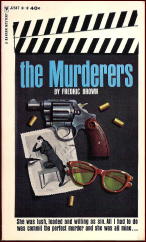
FREDRIC BROWN – The Murderers. Dutton, hardcover, 1961. Bantam J2587, paperback, 1963.
— Knock Three-One-Two. Dutton, hardcover, 1959.Bantam A2135, paperback, 1960.
I’ve had a couple Fredric Brown’s on my shelf since Hubin-knows-when, but when I glanced at the covers the other day I couldn’t for the life of me remember reading them.
The Murderers is pleasantly amoral right up to the cop-out ending. Two unemployed actors find their careers stymied by different adverse circumstances and decide to solve their problems by swapping murders. Everything goes along smoothy and even enjoyably until … well, as I aid, the ending’s a disappointment, but it doesn’t come until late in the book, which is mostly slick and much fun.
Knock Three-One-Two is just as contrived and just as enjoyable. Ray Fleck, the hero of the piece is a two-bit, two-timing, half-smart chiseler and gambling addict (though the term was unknown back then) looking to score the Big One that will wipe out his debts and get him back in the Game.
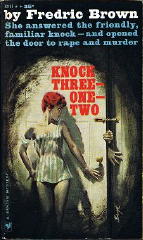
Knock is the account of his night-long unlucky odyssey to that elusive home, set against the backdrop of a city plagued by an elusive serial killer.
It’s something to the credit of Brown’s writing that the extraordinary contrivances of this thing don’t seem all that apparent until you set it down and start thinking about it.
SPOILER ALERT — PLOT DETAILS AHEAD!
Every bet that Ray makes he loses, every ploy he tries backfires, every turn he takes is wrong one, right up to the end, when he gets the chance to score several thousand dollars of insurance money — by steering the Serial Killer to his wife.
END OF WARNING.
The resolution is unsurprising, but Brown delivers the package neatly enough that it’s a pleasure reading it.
Next Page »



